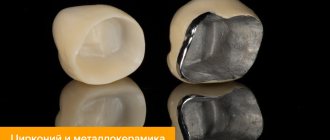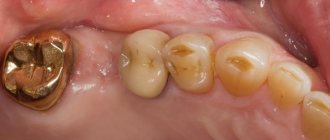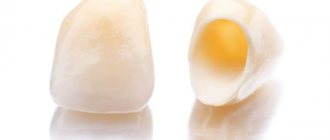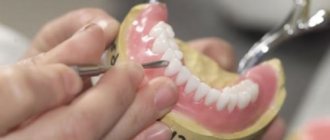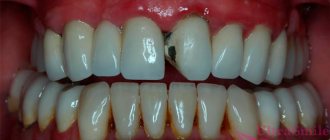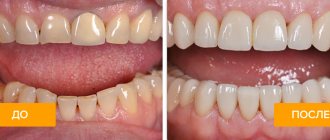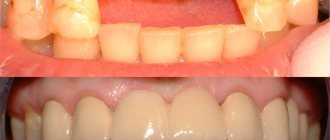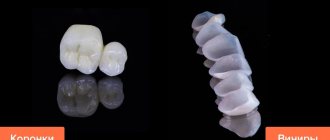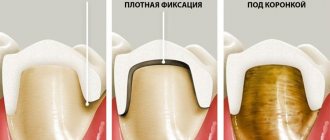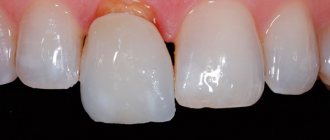Metal-ceramic crowns are a reliable, long-term way to restore teeth. Although cermet material is very durable, it is not eternal. The patient sometimes encounters cracks, abrasions, chips or scratches on the surface of the crown. Damage to ceramic cladding is caused by:
- High chewing load (too hard food);
- violation of the manufacturing technology of a crown or prosthesis;
- incompatibility of frame base and cladding materials;
- violation of installation technology (long prosthesis, incorrectly selected abutment teeth);
- bite problems;
- bruxism (teeth grinding).
Damage to the ceramic lining disrupts the aesthetics of the prosthetic structure and its functionality. But this is no reason to despair. The damaged surface can be restored, returning the crown to its original appearance. The main method of restoring a chipped crown without removing it is the restoration of metal ceramics with a light-curing composite.
Types of crowns
Metal-ceramic crowns differ in the metal alloy from which the frame is made, the manufacturing method, and service life. In most cases, an alloy of base metals (chromium-nickel, chromium-cobalt) is used to make the frame. They are durable, reliable, and not subject to deformation. This is a budget option that, with proper care, will last 8-10 years.
Often the frame is made of an alloy of gold with palladium, platinum, and silver. These are hypoallergenic materials that have an antibacterial effect, containing up to 80-90% gold. Ceramic-lined structures look natural, so they are perfect for installation in the smile area. Service life – up to 12-15 years.
When it comes to prosthetics on implants, the base of the crown is made of titanium. The material is compatible with body tissues, does not cause allergies, and eliminates the development of galvanic effect (galvanosis). Such structures will last 15 years or more.
According to manufacturing technology, metal-ceramic crowns can be cast or milled. Ceramic mass is applied layer by layer to the finished frame, made by any method, firing each subsequent layer. Modern dentistry has solved the problem of the “blue” strip around the gums, which made the installation of metal-ceramic structures on the front teeth undesirable. Today, crowns with shoulder mass are used - the manufacturing technology provides for a special ledge, which is also lined with ceramics to avoid oxidation of the metal upon contact with the gum. This makes the prosthesis aesthetic, allowing you to restore incisors and canines.
Description of material
Metal-ceramic crowns are made from an individually made plaster cast and consist of a metal base and a ceramic surface.
The frame can be made from alloys of noble metals (gold, silver, palladium) or from base alloys (nickel, chromium, cobalt).
The strength of the structure is ensured by the frame, which fully performs the functions of the lost tooth. And thanks to the ceramic lining, the artificial tooth looks almost the same as a natural one.
To reduce the fragility of the crown , the technology of layer-by-layer application of ceramics to the outer surface of the metal is used, then securely fixed by sintering.
Although metal-ceramic structures are considered strong and durable, it is precisely on such products made from combined materials that chips most often form. This mainly occurs in people who prefer solid foods.
Restoration methods
Shallow cracks and abrasions are eliminated by polishing the ceramic surface. Small chips are restored using light-curing composites. This is the most common way to restore an orthopedic system without replacing it. Restoration of metal ceramics includes the following stages:
- The extension area is isolated from moisture;
- grind the chipped area to improve the adhesion of materials;
- after drying, a composite material is applied to the defect layer by layer, each layer is illuminated with a UV lamp;
- Upon completion of the extension, the area is ground and polished to give a natural shine, the appearance of a crown.
Repairing a metal-ceramic chip takes about 30 minutes. Restoration extends the life of the prosthesis, restores the original appearance, and returns the aesthetics and functionality of the dentition. However, repair of chips on metal ceramics is carried out without a guarantee, since there are many negative factors that affect the service life of the restoration.
If a metal-ceramic crown breaks off, there is no need to throw away the fragment. It is likely that the doctor will be able to use it to restore the integrity of the lining. In case of extensive damage, when a significant part of the metal is exposed, or chips of the lining of the contact surfaces, another option is required - replacing the damaged structure with a new one.
Causes of damage
At the junction of the metal base and the ceramic lining, strong stresses sometimes occur, which can cause chips or other damage to the ceramic.
The main reasons for the formation of ceramic chips include:
- a large difference between the coefficients of thermal expansion of metal and ceramics;
- the intermediate part of the bridge structure is too long (bases made of noble metals have little rigidity, so with excessive chewing loads, chips on the surface may occur);
- malocclusion , sometimes in combination with pathological grinding of teeth;
- unprofessional tooth preparation (insufficient removal of hard tissues from the chewing surface);
- carrying out large-scale orthopedic work without the use of special equipment;
- the use of too thick cement to fix the metal-ceramic structure;
- entry of foreign bodies between the prepared tooth and the crown;
- poorly performed technical and laboratory work;
- injuries after a blow , fall, etc.;
- improper handling of artificial teeth by the patient (increased loads, temperature changes).
Technique for removing a crown from a tooth without damaging it and the devices used.
Come here if you want to take a closer look at the Noritake metal-ceramic crown.
At this address https://www.vash-dentist.ru/protezirovanie/nesemnyie-p/koronki-np/kachestva-metallokeramicheskih-duceram.html you will find reviews about Duceram metal-ceramic crowns.
How is a crown replaced?
Installation of a dental crown is a non-removable prosthetic method. This means that the patient cannot remove the structure on his own. This is done exclusively in a clinical setting. After the specialist has decided to replace the structure with a new one, in order to facilitate the removal of the damaged crown, it is carefully sawed or the cementing composition is destroyed with ultrasound. In this case, the crown can be removed without damaging it.
After removing the structure, the dentist assesses the condition of the supporting tooth and, if necessary, treats it. Upon completion of treatment and filling, repeated prosthetics are performed. That is, dental impressions are taken again, a prosthesis is made in the laboratory, and after fitting, the finished structure is fixed with cement.
The choice of material for a new dental crown depends on the clinical picture and the wishes of the patient. Often, when it is necessary to replace an old structure with a new one, the patient wants to improve the aesthetics by changing metal ceramics to solid ceramics or zirconium dioxide.
Reviews
Most often, crowns are damaged after injury or due to improper dental care. Experts believe that it is necessary to restore chips as early as possible in order to avoid complete destruction of the product.
If you want to ask any questions about restoring the integrity of the crown or simply share your feedback, write them in the comments to this article.
If you find an error, please select a piece of text and press Ctrl+Enter.
Tags dental crowns metal-ceramic crowns fixed dentures
Did you like the article? stay tuned
Previous article
An anti-snoring mouthguard is a worthy alternative to surgery
Next article
On the rationality of coronoradicular separation
Recovery technique after removal
Repairing a ceramic prosthesis is a complex manipulation that requires the doctor not only to have professional qualifications, but also to have good practice. After all, an unsuccessful attempt to remove the structure can completely destroy it.
The entire process is carried out using special tools and devices:
- a device with a tip that looks like a thin hook;
- forceps;
- separator bolt;
- pneumatic hand devices;
- mechanical prosthesis extractors.
The dentist carries out all his actions under local anesthesia, so the patient does not experience pain.
After the upper part of the structure is removed from the oral cavity, it is transferred to a special laboratory, where a dental technician will return it to its original appearance. The manipulation takes no more than three hours.
If the broken fragment was saved , it is simply glued into place with medical quick-drying glue.
If the fragment is not preserved , then the missing element is formed anew by applying multi-layers of ceramics. When the desired shape is achieved, the workpiece is dried under high temperatures in special ovens.
The final stage is grinding off excess fragments, grinding and final polishing using the previously discussed method.
This method is not particularly popular, since the percentage of damage to the frame of an artificial tooth during its extraction is quite high.
It is associated with trauma to the gums and soft tissues of the mucosa. And the guarantee that the new model will last a long time is very doubtful.
Installation of the prosthesis
The main indication for the use of ceramics and metal-ceramics is a strong tooth root, but a large absence of a coronal part. Other clinical cases in which prosthetics are required: severe pigmentation of tooth enamel, progressive diseases of dentin of a non-carious nature, destruction of enamel under the influence of external or internal factors.
The preparatory stage is similar to the work of installing a composite; then the prosthetic tooth is ground down and a pin is placed in the canal. If the root is strong, but the tooth’s “own” crown is almost completely absent, a stump (inlay) is installed. This design strengthens the dental canals and allows the prosthesis to be securely fixed.
Damaged crowns made of metal-plastic and ceramics are restored “in situ”; metal-ceramic structures, as a rule, must be replaced
Forecast
Regardless of which of the listed methods the restoration was carried out, it is very difficult to name a specific service life.
This is determined by the following factors:
- the magnitude of the damage - with sufficiently large chips, the risk that the new prosthesis will collapse quickly is much greater than with minor damage;
- the base of the product - if made of metal, the adhesion force with the composite is lower than with ceramics;
- bite pathology – a defect can provoke new damage immediately after repair;
- oral care
- bridge system is too long;
- insufficient tightness of the adhesion during the restoration process - over time, it loses its ability to set even more, and the fragment will break off again.
